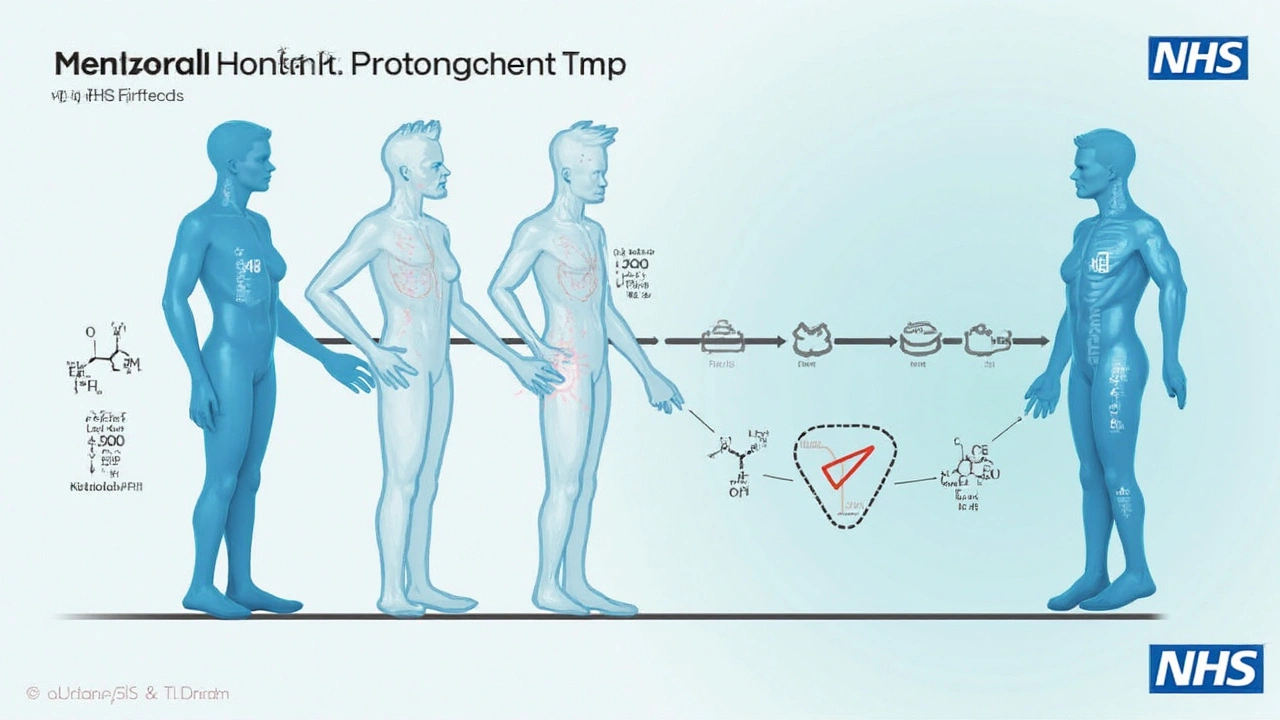Ever been handed a prescription for ketorolac and wondered if it’s just another painkiller, or something you should take seriously? You’re not alone. Ketorolac isn’t like popping a couple of regular ibuprofen—it packs a punch and has to be used with care.
Doctors love ketorolac for knocking out moderate to severe pain, especially after surgery or an injury. But here’s the thing: this isn’t a drug you grab off the pharmacy shelf for a headache or sore knee. It’s strong, works pretty fast, and comes with some rules. You’ll usually see it given as a shot or in pill form for just a handful of days, max.
If you’ve been prescribed ketorolac or are thinking about it after hearing a friend mention it, it pays to know what you’re dealing with. There’s a good reason you’ll get a time limit right on the label, and missing side effect warnings can land you in a rough spot.
- What Exactly Is Ketorolac?
- How Ketorolac Works for Pain
- Safety and Side Effects
- Smart Use and Doctor Tips
What Exactly Is Ketorolac?
Ketorolac is a powerful pain relief drug, but it’s not your everyday over-the-counter option like ibuprofen. It belongs to a group called nonsteroidal anti-inflammatory drugs, or NSAIDs. This means it both fights pain and helps cut down on swelling.
The big draw with ketorolac is its strength. Doctors turn to it for short-term pain, especially right after surgeries, dental procedures, or injuries where regular painkillers just don’t cut it. You’ll usually see it given as a shot in the hospital, but there are pills and even eye drops for certain conditions.
Here’s a straight-up fact: you can’t use ketorolac for more than 5 days. That’s because it comes with higher risks for side effects if you keep taking it. Most pain relievers you see at the store are safe for longer, but ketorolac is in a different class due to its intensity and potential risks.
If you’re wondering how it stands out from other meds, look at the numbers. In a head-to-head comparison, ketorolac often matches or beats morphine for post-op pain in the first six hours, but without the grogginess and slow recovery that opioids can bring.
| Form | Usual Use | How long? |
|---|---|---|
| Injection | Hospitals, post-surgery | 1-2 days |
| Pills | After injection, if needed | Up to 5 days total |
| Eye Drops | Eye surgery or inflammation | As prescribed |
Bottom line: ketorolac is your go-to when pain is sharp and quick, not for nagging aches or everyday soreness. You’ll rarely see it in someone’s home medicine cabinet for a reason—it’s a short-term solution with some serious chops.
How Ketorolac Works for Pain
So, what’s the deal with ketorolac and pain? It’s actually part of the NSAID family—that’s nonsteroidal anti-inflammatory drugs, just like ibuprofen or naproxen. But ketorolac is a big step up in strength. It works by blocking enzymes (COX-1 and COX-2) that your body uses to make prostaglandins—the chemicals that cause pain and swelling when something’s not right.
When you get hurt or have surgery, your tissue spits out prostaglandins, leading to pain, inflammation, and swelling. Ketorolac blocks that chain reaction. It doesn’t just dull the pain; it actively tones down the inflammation, so swelling goes down, and the pain isn’t as intense or nagging. That’s why hospitals love using it for short-term, intense pain after things like knee surgery, dental work, or a twisted ankle.
Here’s something to keep in mind: the way you take ketorolac affects how it works. If you get it as an injection, you’ll feel the pain relief in less than an hour—sometimes in just 30 minutes. The pill form takes a bit longer, but the effect sticks around for four to six hours. That’s short but powerful, so doctors usually only give it for up to five days to avoid serious side effects.
| Ketorolac Form | Onset of Action | Typical Duration |
|---|---|---|
| Injection | 20-60 minutes | 4-6 hours |
| Pill (oral) | 30-60 minutes | 4-6 hours |
Don’t forget, taking it too long or combining it with other NSAID painkillers ups your risk for stomach ulcers, kidney issues, and even bleeding. Always double-check with your doctor about what’s safe to take together—seriously, don’t guess on this one.

Safety and Side Effects
Here’s where ketorolac really sets itself apart: the side effects. This isn’t a medicine you mess around with for weeks. Even the FDA says you should never use ketorolac for more than five days because the risks go up the longer you take it.
The most common problems are stomach-related. This drug can cause ulcers, bleeding, or even holes in your gut. That’s why doctors steer clear of prescribing it to anyone with a history of stomach ulcers or GI bleeding. If you feel pain or notice blood in your stool after taking ketorolac, call your doctor—seriously, don’t wait around.
- NSAID risk: Like other strong NSAIDs, ketorolac can mess with your kidneys, especially if you already have kidney issues, are elderly, or get dehydrated easily.
- It can also bump up your blood pressure or put strain on your heart. For people with heart disease, that’s a big red flag.
- Allergic reactions do happen, especially if you’ve reacted badly to aspirin or other NSAIDs before. If you break out in hives, struggle to breathe, or your lips start swelling, that’s your cue for urgent care.
People sometimes forget ketorolac interacts with other meds. Mixing it with blood thinners, steroids, or other NSAIDs can be a recipe for disaster—think increased bleeding or GI issues.
| Side Effect | How Common? |
|---|---|
| Stomach pain/ulcers | Up to 15% |
| Kidney issues | 3-5% |
| High blood pressure | 3-10% |
| Allergic reaction | Rare but serious |
And here’s a tip: always take ketorolac with a bit of food or at least a glass of water to help lower the stomach risk. Never double up your dose to make up for a missed one—just skip it and call your healthcare provider if you’re worried. Play it safe, because this med can be a game-changer for pain, but only if you respect what it can do to the rest of your body.
Smart Use and Doctor Tips
Getting the most out of ketorolac means balancing pain relief with safety. There’s a pretty clear rule with this medication: it’s meant for short-term use only—most doctors won’t prescribe it for more than 5 days in a row. There’s some solid science behind that. Using ketorolac longer than recommended can bump up the risk of stomach ulcers, kidney problems, and bleeding.
Always take the lowest dose that works. Swallow your dose with food or a big glass of water to cut down the chance of stomach trouble. Skip alcohol while you're on ketorolac—mixing the two is rough on your gut and liver.
- Don’t double up if you miss a dose. Just wait for the next one.
- Never use ketorolac with other NSAIDs (think aspirin, ibuprofen, or naproxen) unless your doctor says it’s okay.
- Let your doctor know if you’ve got history of stomach issues, kidney problems, or if you’re on blood thinners.
- Tell your doctor about all other meds and supplements you’re using—some can react badly with ketorolac.
Age matters here, too. If you’re over 65, your doctor might lower your dose or suggest a different pain reliever since older adults have a higher chance of side effects.
Feel weird side effects like new bruising, black stools, severe headaches, or swelling? That’s your cue to call your doctor immediately. And here’s a stat that might surprise you: roughly 1 in 100 people on ketorolac will have stomach or gut problems bad enough to need medical help, so the warning isn’t just hospital spiel.
| Key Tip | Why It Matters |
|---|---|
| Short-term use (max 5 days) | Prevents serious kidney, stomach, and bleeding problems |
| Take with food/water | Lowers risk of stomach upset |
| No 'doubling up' doses | Reduces overdose risk |
| Avoid with other NSAIDs | Cuts down on harmful side effects |
Most important? Trust the instructions on the label and what your doctor says. Ketorolac can be a real lifesaver, but only if you stick with the plan and ask questions when you’re unsure.









Ketorolac is a potent COX‑1/COX‑2 inhibitor; limit to 5 days to mitigate nephrotoxicity and GI ulceration.
Wow, what a powerful tool for acute pain relief! Remember, the short‑term nature of ketorolac means you can bounce back faster, so stick to the prescribed window and hydrate well!! If you follow the dosing schedule, you’ll avoid those nasty stomach issues and stay on track for a speedy recovery!!!
Listen up-ketorolac can knock out post‑op pain like a champ, but don’t think you can abuse it. Keep the dose low, take it with food, and never exceed five days, or you’ll be fighting kidney damage and bleeding. Stay sharp and follow the doc’s orders, or you’ll pay the price.
Ketorolac sits at a fascinating crossroads of pharmacology, where the chemistry of COX inhibition meets the art of acute pain management. 🌟 Its efficacy stems from a tight binding to both COX‑1 and COX‑2 enzymes, curbing the cascade of prostaglandins that scream “ouch” after tissue trauma. When you consider the rapid onset-often within thirty minutes for oral doses-you can appreciate why surgeons favor it in the immediate postoperative window. Yet, this rapidity carries a double‑edged sword, as the same potency that silences pain can also erode the gastric mucosa if left unchecked. The five‑day ceiling isn’t an arbitrary number; it reflects a balance between analgesic benefit and the rising tide of renal insufficiency and gastrointestinal bleeding. Think of it as a high‑performance sports car: exhilarating on the straightaway, but you must respect the speed limits to avoid catastrophic failure. For patients with a history of ulcers, the risk amplifies, demanding co‑prescription of proton‑pump inhibitors or alternative analgesics. In the elderly, reduced renal clearance can turn a therapeutic dose into a toxic insult, so dosing adjustments become non‑negotiable. Moreover, concurrent use of other NSAIDs or anticoagulants compounds the danger, creating a perfect storm of bleeding risk. 📚 The literature cites up to 15 % of users experiencing significant stomach pain, a reminder that the drug’s power is not without cost. It is also worth noting that ketorolac does not possess the opioid‑like sedation, making it ideal for patients who need to stay alert post‑surgery. However, the lack of sedative effect does not absolve clinicians from monitoring blood pressure, as vasoconstriction can elevate systemic pressures. Patients should be counseled to maintain adequate hydration, because dehydration can precipitate acute kidney injury under ketorolac’s grip. The pharmacodynamic profile tells us that after cessation, prostaglandin synthesis resumes, which may uncover rebound pain if the underlying cause isn’t addressed. Ultimately, the judicious use of ketorolac hinges on a partnership between prescriber and patient, where clear communication about duration, dosage, and warning signs is paramount. 🌈
It’s reckless to think any NSAID is a free pass; ketorolac’s bleeding profile makes it one of the most dangerous options if misused. Doctors who hand it out without strict monitoring are practically inviting gastrointestinal catastrophes, and the side‑effects don’t forgive casual users. You can’t blame the drug for ulcers when the patient ignored the “no alcohol” warning and doubled up on doses. This isn’t a casual over‑the‑counter remedy, it’s a high‑stakes prescription that demands respect.
From a safety standpoint, the data shows a clear correlation between prolonged ketorolac use and renal impairment, especially in patients with pre‑existing kidney issues. Monitoring serum creatinine during therapy can catch early signs of trouble before irreversible damage occurs.
As an American who champions our cutting‑edge medical advancements, I can say that ketorolac exemplifies the ingenuity of U.S. pharmaceutical research-delivering potent analgesia that rivals morphine without the same dependence risk. Yet, with great power comes great responsibility, and we cannot let patriotic pride blind us to the drug’s dark side. The United States has set rigorous FDA guidelines precisely to curb the abuse that could otherwise lead to a public health crisis. When patients think “it’s made here, it must be safe,” they overlook the strict clinical trials that exposed the hemorrhagic dangers. Our clinicians must enforce the five‑day limit like a battle‑standard, and any deviation should be met with the same severity as a breach of protocol on the front lines. The dramatic contrast between rapid pain relief and the looming threat of ulcer perforation reads like a thriller, underscoring the need for vigilance. Let’s honor the innovation by using it wisely, not recklessly.
I completely understand the worry that comes with a strong medication like this 😊. It’s important to keep an eye on any stomach discomfort, and if you notice blood in your stool, seek help right away. Also, try to take the pill with a full glass of water and a small meal-this simple step can reduce irritation. If you have any doubts about interactions with other meds, a quick chat with your pharmacist can clear things up. Stay safe and take care! 🌸
Ketorolac works fast and should only be used short term it is not meant for chronic pain management please follow the dosing schedule and avoid alcohol while on the medication
Looking at the overall risk‑benefit profile, one could argue that the convenience of a potent oral NSAID outweighs the potential for gastrointestinal complications in a healthy adult, provided that the prescription is adhered to strictly. The literature does suggest a dose‑response relationship where higher cumulative exposure increases the likelihood of ulcer formation, yet many patients tolerate the standard regimen without incident. It is also noteworthy that the drug’s renal effects are dose‑dependent, and monitoring renal function is advisable for anyone with borderline kidney health. In practice, the decision to prescribe ketorolac often comes down to a clinical judgment call, balancing the need for immediate pain control against the relatively low incidence of serious adverse events when used appropriately. Patient education on the signs of bleeding and the importance of staying within the five‑day window can mitigate many of the concerns that are sometimes over‑emphasized in cautionary discussions.
Don’t be a idiot and think you can keep taking it forever. The drug will mess up your stomach and kidneys if you dont stop in five days. Listen to the doc or you will pay the price later.
Stay on schedule and you’ll be back on your feet fast.
It’s astonishing how many people treat ketorolac like a miracle cure, oblivious to the lurking specter of bleeding and renal failure that follows any deviation from the strict five‑day rule. The drama of a patient suddenly confronting a perforated ulcer is a stark reminder that this drug does not forgive carelessness, and those who ignore the warnings are essentially courting disaster. Knowledge should be the armor that protects you from such self‑inflicted wounds.
Hey, just a heads up-make sure you dont take ketorolac with ibuprofen or aspirin. Mixing NSAIDs can really up your risk for stomach bleedin. If you have any history of ulcers, talk to your doctor about alternative pain meds. Stay safe!
Yo! Ketorolac is solid for short‑term pain, but keep it under 5 days, take it with food, and don’t mix with alcohol. If you feel weird stomach pain, hit up your doc. 👍
In many cultures we emphasize balance, and ketorolac is no exception-it offers strong relief but must be balanced with safety measures. Ensure you drink enough water and avoid other NSAIDs while on the drug. If you notice any unusual bleeding, seek medical attention promptly.